Australia ICT Market Size
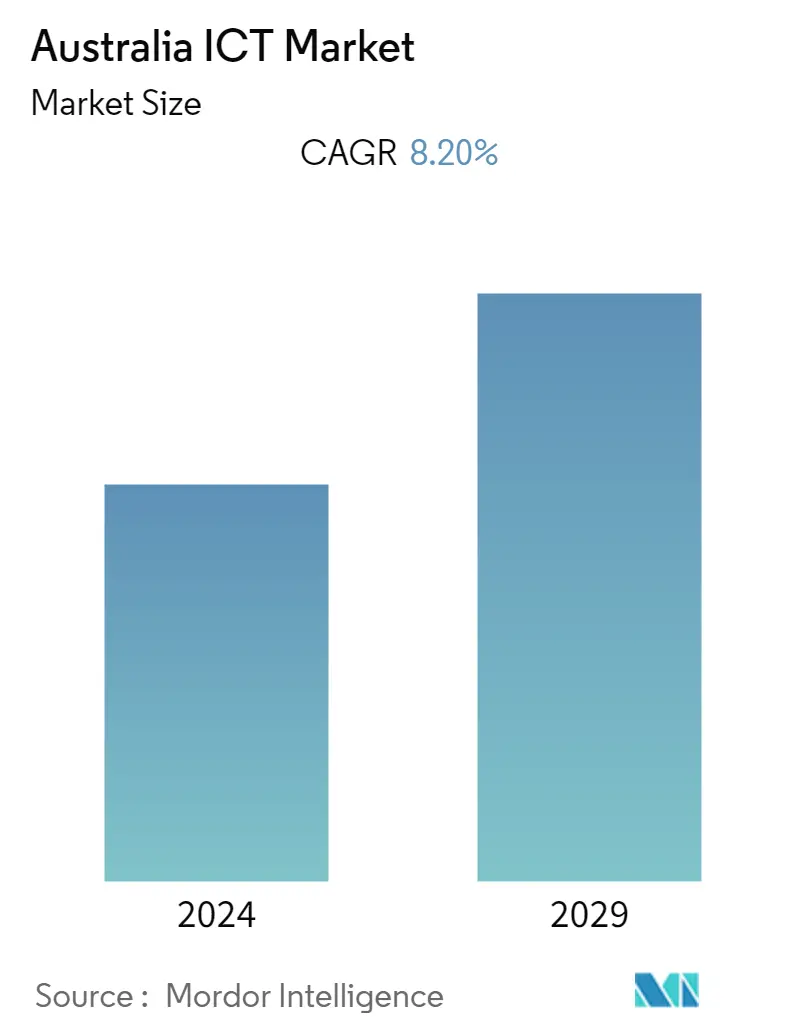
| Study Period | 2019 - 2029 |
| Base Year For Estimation | 2023 |
| Forecast Data Period | 2024 - 2029 |
| Historical Data Period | 2019 - 2022 |
| CAGR | 8.20 % |
| Market Concentration | Medium |
Major Players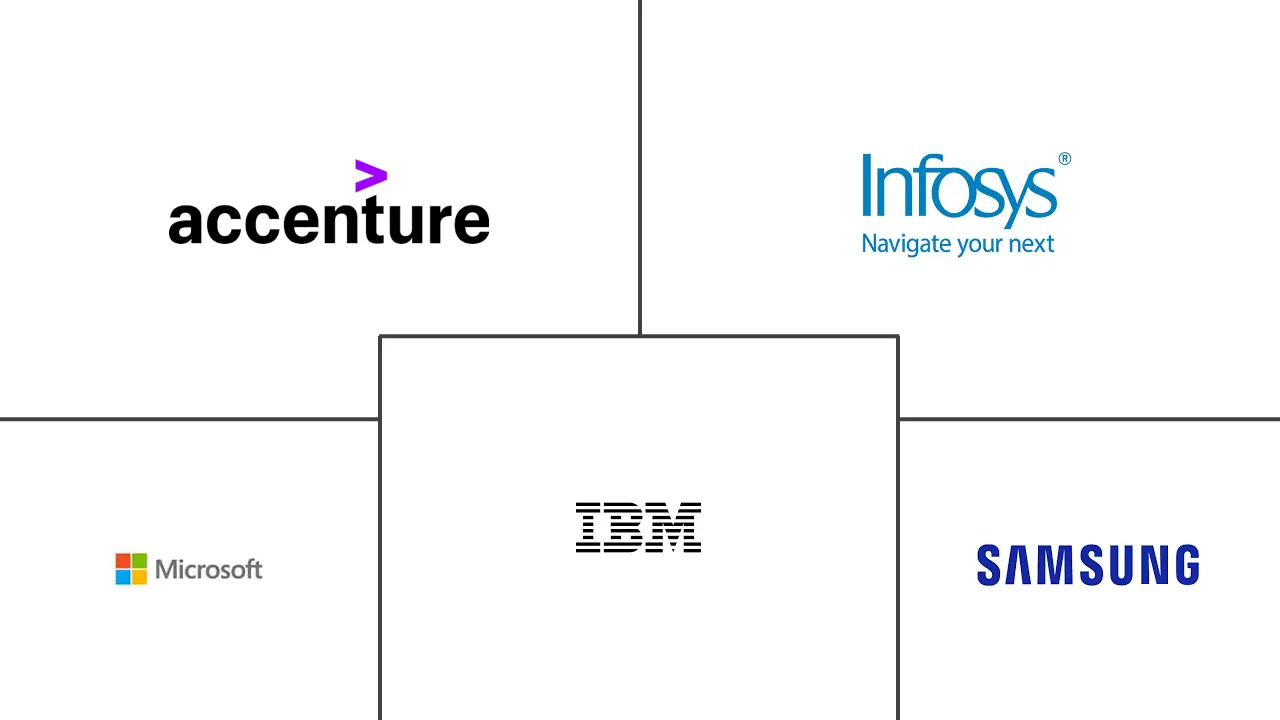
*Disclaimer: Major Players sorted in no particular order |
Need a report that reflects how COVID-19 has impacted this market and its growth?
Australia ICT Market Analysis
The Australian ICT market is expected to expand at a CAGR of 8.2% over the forecast period. The growing emphasis on digital technology, cyber security, artificial intelligence, robotics, and healthcare IT in Australia is driving the market's growth significantly. Moreover, a significant research infrastructure and a technology-hungry, solutions-driven customer base make Australia a strategic location for a vast range of ICT activities with a regional and global focus.
- Major world-recognized brands are taking advantage of what Australia offers in the ICT market. Global names such as Avaya, Canon, and IBM have built product development (R&D) facilities in Australia. Google Maps and Warner Bros have used their bases in Australia to develop profitable international digital content for the business and entertainment sectors. Alcatel-Lucent, Cisco Systems, and CSC run advanced technical assistance centers for operations around the world from Australia, and Logica CMG, Reuters, and Infosys have made Australia central to their global risk reduction strategies.
- Moreover, the surge in demand to explore and adopt digital technologies and initiatives, the increase in the overall demand for digitalization and scalable IT infrastructure, the wide adoption of the 5G network, and the rising penetration of technology giants are boosting the growth of the market significantly.
- Furthermore, the increase in the Australian Government's IT expenditure significantly fuels the growth opportunities of the market. As per the Australian Computer Society, in 2022, Australian Federal Government's spending on IT services was forecasted to total 6.4 billion Australian dollars, whereas it was about 6 billion Australian dollars in the year 2021. Other critical areas of IT spending included telecom and devices. However, software expenses were anticipated to attract the second-largest funding of over 4 billion Australian dollars in 2022.
- However, the fragmented nature of the market, the growing incidence of data breaches, and the country's dependency on external sources to balance the skill deficit are expected to hinder market growth in Australia.
- While the COVID-19 pandemic impacted Australia's digital transformation, companies are realigning their IT strategies, automating processes, managing operational costs, and implementing new systems for better and improved efficiencies. In addition, emerging technologies such as robotic process automation, artificial intelligence, big data, machine learning, cloud computing, the internet of things, blockchain, cybersecurity, and augmented/virtual reality are helping to a great extent to accomplish these goals.
Australia ICT Market Trends
This section covers the major market trends shaping the Australia ICT Market according to our research experts:
Digital Transformation is Expected to Drive the ICT Market in Australia
- The ICT spending in Australia is primarily driven by the growing adoption of advanced technologies, such as artificial intelligence, cloud computing, big data, and the internet of things. Additionally, the surge in the adoption of data analytics, the rise in the overall usage of AI and automation, and big data in various end-user industries will likely significantly impact the Australian ICT market in the projected timeframe.
- Furthermore, the Australian Government's continued emphasis on the digital transformation of private and public sector services will drive the market's growth positively. Hence, mobility, cloud computing, data and analytics, digital storage, etc., will witness a high adoption rate in the coming years. All these factors will thus create growth opportunities, supporting the growth of the ICT market in the country.
- For instance, in March 2022, the Australian Government offered USD 44 million to establish AI and Digital Capability Centres, thereby connecting businesses with AI equipment, tools, services, training, and expertise. The centers will help and assist Australian companies in improving their AI skills, connecting small and medium enterprises (SMEs) with AI equipment and tools, increasing the adoption of AI technologies, providing training and guidance on AI technologies, supporting the development and commercialization of AI products, and services for domestic and global markets.
- Also, in March 2022, the Australian Government released the Digital Economy Strategy 2022 Update, which outlines progress made in Australia becoming a top 10 digital economy by 2030. This will also positively impact the market's growth.
- Moreover, the total number of internet users in Australia is growing. As per Hootsuite, the overall share of the Australian population who were active internet users was around 91 % in 2022, whereas it was around 89 % in 2021. Hence this rise in Australia's overall active internet user population will boost the growth of the market over the forecast period.
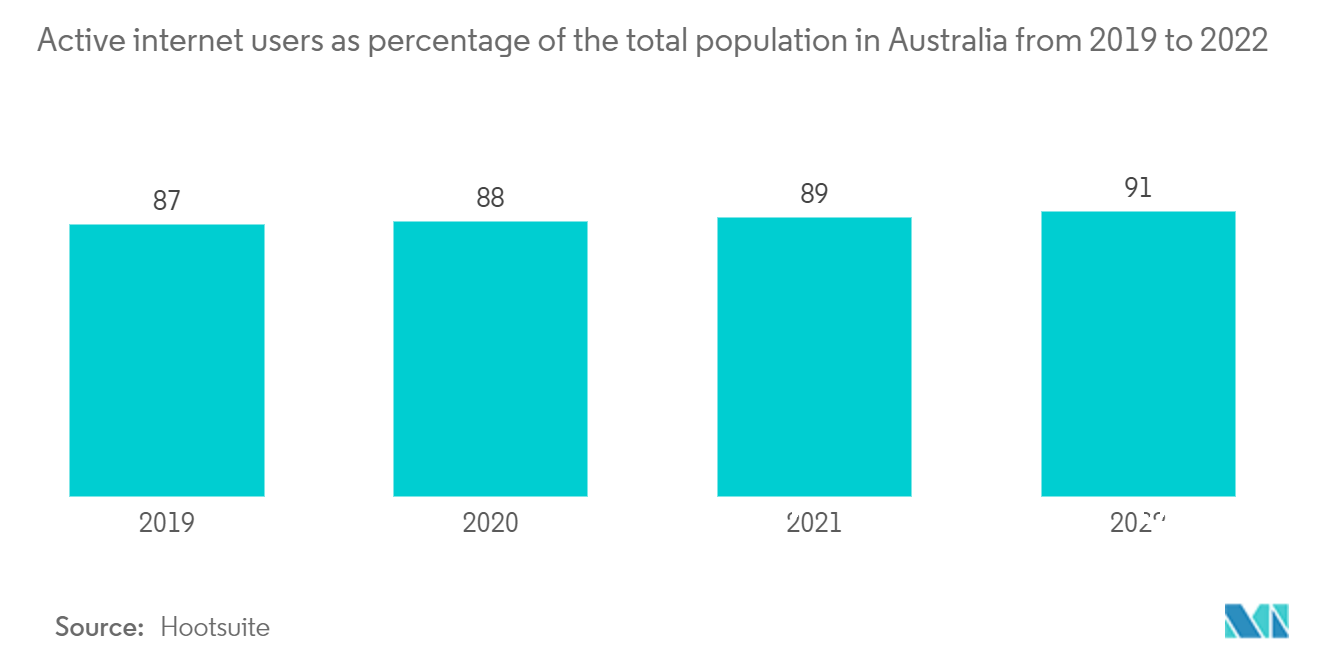
The IT and Telecom Sector is Expected to Drive the Market
- The telecommunications sector is one of Australia's core and essential infrastructure services. The country has one of the most competitive and mature telecommunications markets in the world. Moreover, the country is witnessing constant growth in the overall volume of mobile subscriptions as well as fixed broadband subscribers, which in turn is helping the market to enhance further.
- Moreover, the Australian government is restructuring the telecommunications industry to increase the overall competition and broaden access to broadband services for all Australians, particularly those who live in regional, rural, and remote areas. Earlier this year, the Australian government stated that it had asked the ACCC to investigate the towers used to serve mobile telecoms and other radiocommunications services in rural areas, as well as the viability of offering mobile roaming during emergencies or natural catastrophes. The investigation would greatly focus on the expenses associated with providing towers and related infrastructures, such as land access, and how these costs are reflected in the fee schedules for businesses that need access to towers to provide mobile and other wireless services.
- Further, the market is witnessing mergers, acquisitions, and investments by key players as part of its strategy to improvise business and their presence to reach customers and meet their requirements for various applications. For instance, in the 1stquarter of this year, TPG Telecom, an Australian company, and its rival operator Telstra reached a network-sharing agreement. TPG Telecom's 4G and 5G spectrum would thus become available to Telstra, allowing it to expand its network, improve capacity, and continue to offer the country's largest and fastest network.
- Also, recently, this year, by turning on a new mobile tower in the Jerdacuttup region, Optus has provided much-needed network coverage in rural Western Australia. The new tower, which is situated on the South Coast Highway and is almost six hours southeast of Perth and an hour and a half west of Esperance, offers Optus customers improved connectivity while residing, working, and traveling through the area. The tower boosts Optus' services in the area, provides dedicated capacity and bandwidth, and improves coverage for locals, businesses, and tourists in the area as a crucial town between Albany and Esperance.
- As per the Australian Communications and Media Authority, a survey about the activities performed online among Australian internet users revealed that in 2021, about 79% of respondents had a smart device connected to the internet, excluding computers, tablets, and mobile phones. The total shares of consumers with internet-connected smart devices have grown over the past few years, most likely driven by COVID-19 restrictions. This rise in the overall percentage of consumers with a smart device connected to the internet in Australia will thus significantly boost the market's growth.
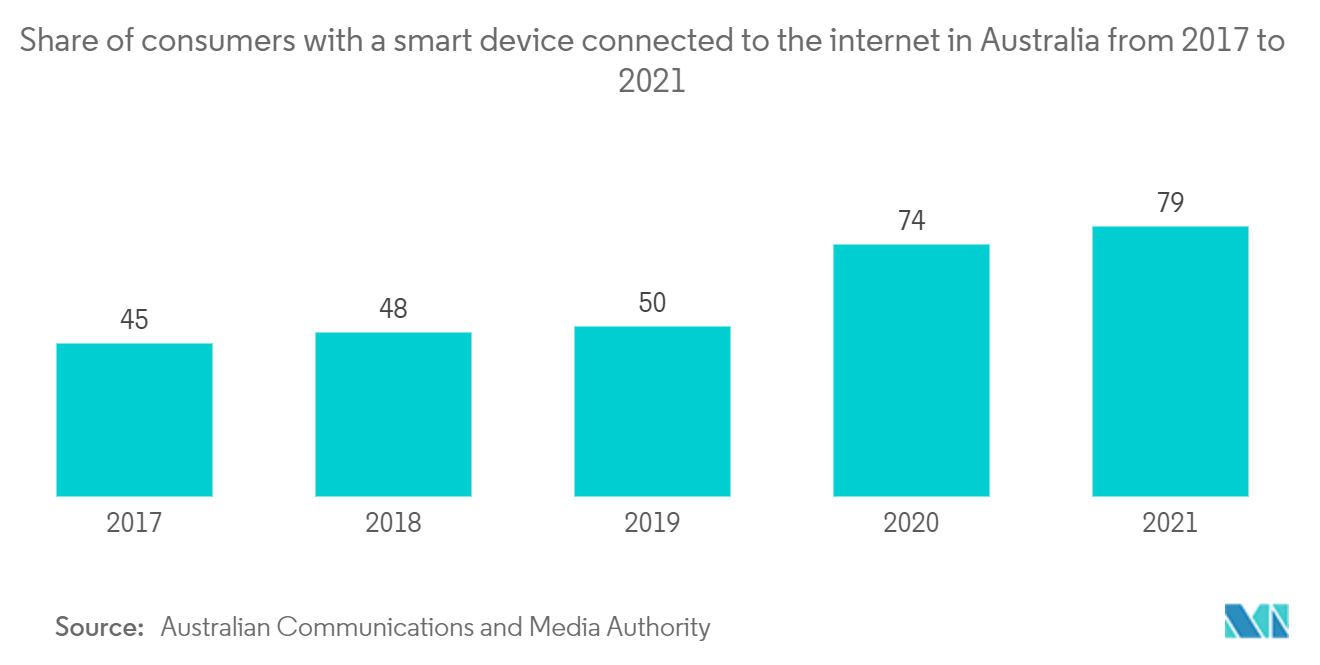
Australia ICT Industry Overview
The Australian ICT market is moderately competitive and moving toward the fragmented stage as the market currently consists of various significant players. Several key players in the ICT market are in constant efforts to bring advancements. A few prominent companies are entering into collaborations and expanding their footprints in developing regions to consolidate their positions in the market. Some of the key developments in the market are:
- In November 2022, SoftIron officially opened Australia's first-ever component-level IT infrastructure manufacturing facility. The facility is Australia's first advanced manufacturing hub that produces ICT componentry for SoftIron's ground-breaking HyperCloud Intelligent Cloud Fabric, the world's first complete technology for building clouds.
- In October 2022, NBN Co welcomed the Government's commitment to invest USD 2.4 billion to roll out more fiber to communities across Australia. The new investment will enable an additional 1.5 million homes and businesses currently served by FTTN (Fibre to the Node) to upgrade to Fibre to the Premises (FTTP). These upgrades will help eligible customers more effectively work from home, operate online businesses, participate in online education, engage in telehealth consultations, stream entertainment, and connect with friends and family.
Australia ICT Market Leaders
Samsung Electronics Co., Ltd
Microsoft Corporation
IBM Corporation
Infosys Limited
Accenture plc
*Disclaimer: Major Players sorted in no particular order
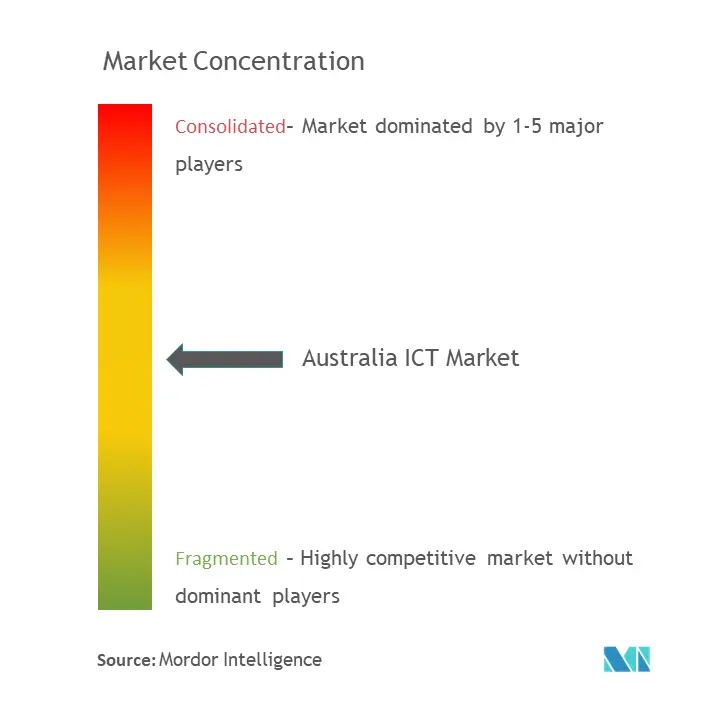
Australia ICT Market News
- November 2022: OPPO Australia launched its 1st tablet in the Australian market, the Pad Air, extending its ecosystem of products. The Pad Air consists of a two-tone metal splicing design. The upper side of the rear panel contains a 3D texture in an OPPO Glow finish, preventing unwanted fingerprints and grooves for a better grip. The lower part of the back panel has been sandblasted with grains of only 0.15mm, creating a slick-like surface.
- March 2022: Tata Consultancy Services opened a Digital Garage Innovation Centre in Australia. The TCS Sydney Digital Garage, Powered by TCS Pace, is the company's first in the Asia-Pacific region. The Digital Garage will support local digital transformation projects. It provides access to TCS' global ecosystem of academia, startups, and technology providers.
Australia ICT Market Report - Table of Contents
1. INTRODUCTION
1.1 Market Definition and Scope
1.2 Study Assumptions
2. RESEARCH METHODOLOGY
3. EXECUTIVE SUMMARY
4. MARKET INSIGHTS
4.1 Market Overview
4.2 Industry Stakeholder Analysis
4.3 Industry Attractiveness-Porter's Five Force Analysis
4.3.1 Bargaining Power of Suppliers
4.3.2 Bargaining Power of Consumers
4.3.3 Threat of New Entrants
4.3.4 Threat of Substitute Products
4.3.5 Intensity of Competitive Rivalry
5. MARKET DYNAMICS
5.1 Market Drivers
5.1.1 Surge in the need to explore and adopt digital technologies and initiatives
5.1.2 Rise in the Government Initiatives
5.1.3 Increase in the overall demand for Digitalization and Scalable IT Infrastructure
5.2 Market Restrain
5.2.1 Fragmented Nature of the Market and the Growing Incidence of Data Breaches
5.2.2 Dependency on External Sources to Balance the Skill Deficit
5.3 Impact of COVID-19 on the IT Spending
6. KEY TECHNOLOGY INVESTMENTS
6.1 Cloud Technology
6.2 Artificial Intelligence
6.3 Cyber Security
6.4 Digital Services
7. MARKET SEGMENTATION
7.1 By Type
7.1.1 Hardware
7.1.2 Software
7.1.3 IT Services
7.1.4 Telecommunication Services
7.2 By Size of Enterprise
7.2.1 Small and Medium Enterprises
7.2.2 Large Enterprises
7.3 By Industry Vertical
7.3.1 BFSI
7.3.2 IT and Telecom
7.3.3 Government
7.3.4 Retail and E-commerce
7.3.5 Manufacturing
7.3.6 Energy and Utilities
7.3.7 Other Industry Verticals
8. COMPETITIVE LANDSCAPE
8.1 Company Profiles
8.1.1 Apple Inc.
8.1.2 Samsung Electronics Co. Ltd
8.1.3 Cisco Systems Inc.
8.1.4 Microsoft Corporation
8.1.5 Tata Consultancy Services Limited
8.1.6 IBM Corporation
8.1.7 Tech Mahindra Ltd
8.1.8 Infosys Limited
8.1.9 Wipro Limited
8.1.10 Accenture PLC
- *List Not Exhaustive
9. INVESTMENT ANALYSIS
10. FUTURE OF THE MARKET
Australia ICT Industry Segmentation
Information technology is often known as information and communication technologies, or ICT. It covers all forms of media applications and services that let users store, access, transmit, retrieve, and manipulate data in a digital format, including wireless networks, the internet, computers, smartphones, software, social networking, and other media.
The Australian ICT market is segmented by type (hardware, software, IT services, telecommunication services), size of the enterprise (small and medium enterprises, large enterprises), industry vertical (BFSI, IT and Telecom, government, retail and e-commerce, manufacturing, energy and utilities, and other industry verticals). The market sizes and forecasts are provided in terms of value in USD million for all the above-mentioned segments.
| By Type | |
| Hardware | |
| Software | |
| IT Services | |
| Telecommunication Services |
| By Size of Enterprise | |
| Small and Medium Enterprises | |
| Large Enterprises |
| By Industry Vertical | |
| BFSI | |
| IT and Telecom | |
| Government | |
| Retail and E-commerce | |
| Manufacturing | |
| Energy and Utilities | |
| Other Industry Verticals |
Australia ICT Market Research FAQs
What is the current Australia ICT Market size?
The Australia ICT Market is projected to register a CAGR of 8.20% during the forecast period (2024-2029)
Who are the key players in Australia ICT Market?
Samsung Electronics Co., Ltd, Microsoft Corporation, IBM Corporation, Infosys Limited and Accenture plc are the major companies operating in the Australia ICT Market.
What years does this Australia ICT Market cover?
The report covers the Australia ICT Market historical market size for years: 2019, 2020, 2021, 2022 and 2023. The report also forecasts the Australia ICT Market size for years: 2024, 2025, 2026, 2027, 2028 and 2029.
Australia ICT Industry Report
Statistics for the 2024 Australia ICT market share, size and revenue growth rate, created by Mordor Intelligence™ Industry Reports. Australia ICT analysis includes a market forecast outlook to 2029 and historical overview. Get a sample of this industry analysis as a free report PDF download.
